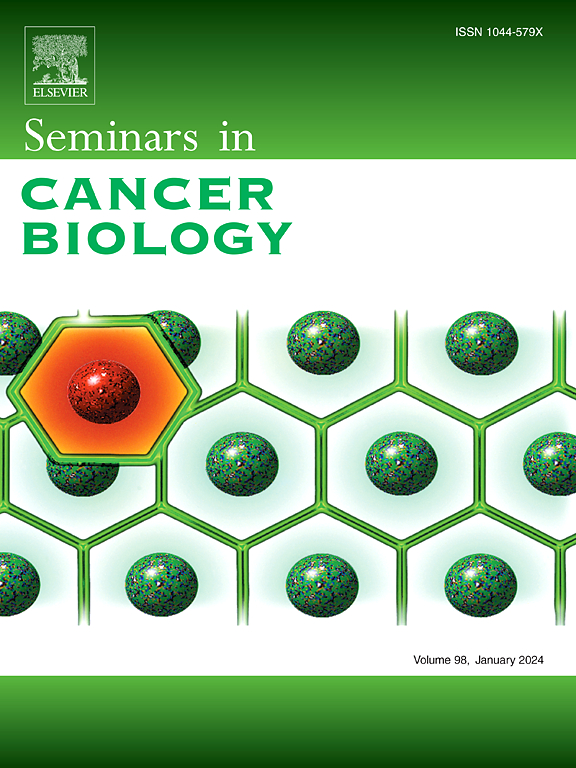揭示胰腺癌抗药性机制的复杂性:体外和体内模型系统的启示。
IF 12.1
1区 医学
Q1 ONCOLOGY
引用次数: 0
摘要
胰腺导管腺癌(PDAC)是一种侵袭性癌症,预后不良,全球死亡人数不断上升。由于缺乏早期症状和生物标志物,诊断较晚,治疗方法主要局限于化疗,而化疗很快就会遇到耐药性。PDAC 的治疗创新因其复杂和异质性的抗药性而受阻,包括关键基因的突变和富含基质的免疫抑制性肿瘤微环境。最近关于 PDAC 抗药性的研究强调,需要合适的体外和体内模型来复制其复杂的分子和微环境。本综述总结了这些模型的研究进展,它们有助于对抗化疗耐药性,并可作为发现新疗法的平台。永生化细胞系具有同质性、无限增殖性和可重复性,但虽然存在许多吉西他滨耐药的PDAC细胞系,但对其他药物耐药的模型却较少。来自 PDAC 患者的器官组织有望模拟肿瘤的异质性和化疗敏感性。目前正在开发生物反应器、共培养系统和结合基质和免疫细胞的有机体切片,以了解肿瘤与基质的相互作用以及肿瘤微环境在耐药性中的作用。最后,另一种创新方法是三维生物打印,这种方法可以创建与 PDAC 结构相似的组织样结构,从而进行药物筛选。这些先进的模型可以指导研究人员选择最佳的体外试验,从而改善治疗策略和患者预后。本文章由计算机程序翻译,如有差异,请以英文原文为准。
Unravelling the complexities of resistance mechanism in pancreatic cancer: Insights from in vitro and ex-vivo model systems
Pancreatic ductal adenocarcinoma (PDAC) is an aggressive cancer with poor prognosis and rising global deaths. Late diagnosis, due to absent early symptoms and biomarkers, limits treatment mainly to chemotherapy, which soon encounters resistance. PDAC treatment innovation is hampered by its complex and heterogeneous resistant nature, including mutations in key genes and a stromal-rich, immunosuppressive tumour microenvironment. Recent studies on PDAC resistance stress the need for suitable in vitro and ex vivo models to replicate its complex molecular and microenvironmental landscape. This review summarises advances in these models, which can aid in combating chemoresistance and serve as platforms for discovering new therapeutics. Immortalised cell lines offer homogeneity, unlimited proliferation, and reproducibility, but while many gemcitabine-resistant PDAC cell lines exist, fewer models are available for resistance to other drugs. Organoids from PDAC patients show promise in mimicking tumour heterogeneity and chemosensitivity. Bioreactors, co-culture systems and organotypic slices, incorporating stromal and immune cells, are being developed to understand tumour-stroma interactions and the tumour microenvironment's role in drug resistance. Lastly, another innovative approach is three-dimensional bioprinting, which creates tissue-like structures resembling PDAC architecture, allowing for drug screening. These advanced models can guide researchers in selecting optimal in vitro tests, potentially improving therapeutic strategies and patient outcomes.
求助全文
通过发布文献求助,成功后即可免费获取论文全文。
去求助
来源期刊

Seminars in cancer biology
医学-肿瘤学
CiteScore
26.80
自引率
4.10%
发文量
347
审稿时长
15.1 weeks
期刊介绍:
Seminars in Cancer Biology (YSCBI) is a specialized review journal that focuses on the field of molecular oncology. Its primary objective is to keep scientists up-to-date with the latest developments in this field.
The journal adopts a thematic approach, dedicating each issue to an important topic of interest to cancer biologists. These topics cover a range of research areas, including the underlying genetic and molecular causes of cellular transformation and cancer, as well as the molecular basis of potential therapies.
To ensure the highest quality and expertise, every issue is supervised by a guest editor or editors who are internationally recognized experts in the respective field. Each issue features approximately eight to twelve authoritative invited reviews that cover various aspects of the chosen subject area.
The ultimate goal of each issue of YSCBI is to offer a cohesive, easily comprehensible, and engaging overview of the selected topic. The journal strives to provide scientists with a coordinated and lively examination of the latest developments in the field of molecular oncology.
 求助内容:
求助内容: 应助结果提醒方式:
应助结果提醒方式:


